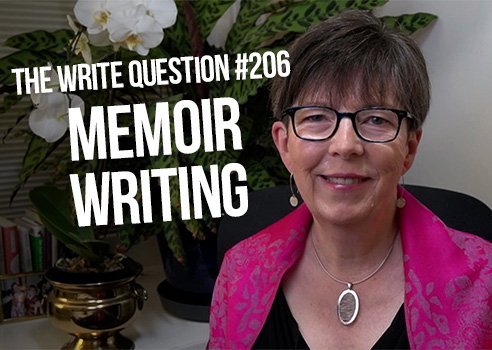Viewing time: 4 mins 53 secs
The Write Question is a weekly video podcast all about writing. Today’s question? How can you better manage your memoir? If you have a question you’d like me to answer you can email me, tweet me @pubcoach, or leave a message for me at the Skype account, The Write Question.
Transcript:
How can you better manage your memoir? That’s the topic I’m addressing today in The Write Question. I’m Daphne Gray-Grant, the Publication Coach.
I have a question from Melanie Barrett, a writer based in Winnipeg, Manitoba. Here’s what she’s asked by email…
“I wrote the first draft of my memoir in real-time, as the situation that I was writing about happened. It’s structured as a series of short conversations followed by chapters given in response. There are flashbacks to 30 years earlier that led to the later events.
Since writing that draft, much has happened and I’ve learned a lot. I want to add more to my memoir but I don’t want to remove the intimate and immersive quality that my first draft has. The trouble is that because I’ve changed and am more informed, I’m not the same narrator as I was before.
I want to revise my memoir so that it contains more reflection and perspective, but without losing the “innocence” of the narrator in my first draft. How do I revise and increase the scope of my memoir with all that I know now?”
Thanks for your question Melanie. Every book presents its own unique challenges and your question is a good example of that.
Sadly, I can’t give you really specific advice without having read your draft. But I can give you a general guideline that I hope will help.
As you know, timelines or chronology are really important for all books. While many writers are tempted to choose strict chronological order for a novel or a memoir — or even chronological order with flashbacks, as you’ve done — there are downsides to that approach.
Chronological order can be a bit boring. Basically, you’re forcing your audience to read about things as they happened. This reduces your ability to highlight the points that are most important. And, as you say, it makes it difficult for you to include the perspective of the wiser and more mature you.
I recently read an interesting memoir that might provide an approach you can work with. The book is called Ladyparts and it’s written by Deborah Copaken.
Copaken is a former war photographer who became a writer, and this memoir is the story of her many health problems and her disappointment with the US medical system. She has a wonderful “conceit” for structuring her book.
Each section relates to a different body part, for which she required surgery. So, each section is told in chronological order, but, overall, the timelines in each section overlap. This gives the book a robust structure and allows her to make her overall point much more forcefully.
Practically speaking, it also allows her to move more quickly between the time when the events happened and the current day and her feelings now.
By the way, I don’t think Ladyparts is a perfect book. I found it too long and I think it would have benefited from a more aggressive edit. But its structure is very smart and effective.
And if you don’t like Ladyparts, I suggest you look for another memoir that has a structure you can use. Essentially, I’m encouraging you to find a model you can emulate. I’ve already done a video on the benefits of using a writing model and I include a link to that in the show-notes below.
People sometimes think it’s “cheating” to use the structures of other authors, but I think that’s just silly. After all, there are a limited number of structures for books and the great artists of any genre — whether it’s painting, sculpture, music or writing — have always copied the works of others.
Finally, let me wrap up with the words of the American playwright Wilson Mizner:
“If you copy from one author, it’s plagiarism. If you copy from two, it’s research.”
Melanie, I’m suggesting you look at how other authors have structured their work, to deal with the challenge you’ve identified for yourself. This structure can give you a template into which you can pour your own ideas and experiences. And the result will be 100% your own.
*
Viewers, if you have any writing-related questions, I’d be happy to do a video on them. Just send me a quick email, daphne@publicationcoach.com, or put a note in the comments section of this YouTube video.
And, if you’d like to learn more about how to make writing a happier and more rewarding process, check out my latest book Your Happy First Draft. I don’t sell it in bookstores or via Amazon. The only place to buy it is on my website, link on the screen below and in the show notes.


